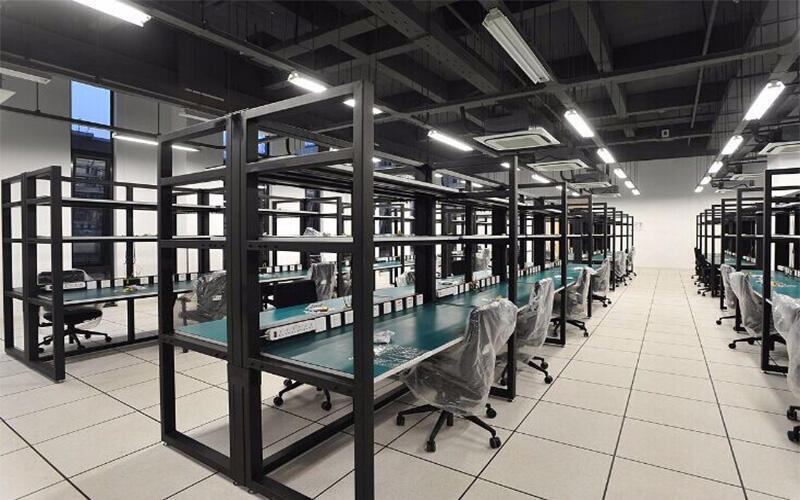Importance of Customization
Robotics in combination with manufacturing sector automation serves as the key factor for ESD workstation progression. New ESD workstations feature designs that make them compatible with automated systems and robotic arms. The integration abilities of ESD workstations increase operational effectiveness and reduce human errors to speed up manufacturing cycles.
By using automation systems with robotics the direct contact between humans and sensitive components decreases ESD-related breakdowns. Robotic systems operating within controlled environments work with more precision than human operators thus enhancing both reliability and safety standards of ESD-sensitive manufacturing processes.
Advanced Monitoring and Alert Systems
excessive use of modern ESD workstation monitoring systems with alert systems will transform all existing protection methods for electronic components. The monitoring tools employ real-time electrostatic discharge measurements that log events automatically. The systems use specialist sensors to measure ESD levels until warning alerts are triggered automatically when the set thresholds indicate technicians should act immediately.
The modern monitoring systems deliver real-time operation alongside a series of alert procedures that display visual feedback and alarm signals and instantaneous text messages sent to technicians' devices. A proactive system enables businesses to quickly address potential ESD issues thus shielding their production assembly lines from destruction.
Modern ESD monitoring systems apply machine learning algorithms to evaluate this phenomenon by detecting upcoming threats before they occur physically. These platforms perform electrotechnical system vulnerabilities analysis through their data analytic systems to enhance total production safety.
Future ESD workstations will receive technological upgrades that will merge with new material advancements throughout the next few years. The next-generation advanced ESD workstations require an integration of smart technology with IoT along with sustainable materials and compatible robotic automation systems and advanced monitoring features.
Electronic companies that need ESD workstations should purchase specialized equipment racks along with anti-static mats and magnification tools. A laboratory will probably focus on selecting ergonomic seating together with cleanroom compatibility along with precision instrumentation setups. Workstations built with modular elements will continue to fulfill multiple requirements without requiring personnel to rebuild the equipment when adjustments are required.
Case Studies of Customized Workstations
This section demonstrates how tailoring your ESD workstation brings practical advantages through evaluations of specific industrial cases. Custom solutions show how they solve particular challenges in order to boost both operational efficiency and safety standards.
Examples from Various Industries
Electronics Manufacturing
A prominent electronics producer operated under perpetual pressure from electrostatic damage which harmed its components. Applied customized ESD workstations with floor and table grounding systems plus wrist straps and ionizers and conductive floors enabled the organization to lower its component failures. Employees at this manufacturing site could change their workstation configurations to fit each task requirement since assembly work and testing and packaging operations needed different set-ups.
Biomedical Research Facility
The biomedical research facility needed workstations which maintained strict cleanliness requirements together with ESD protection features. The custom workstations utilized sterilizable materials which established resistance to microbial activities. The workstations received built-in ESD protection through stationary surfaces connected to the ground in addition to anti-static storage units. The personalized design achieved two essential goals by enhancing research equipment security while maintaining the essential cleanroom requirements for biomedical testing.
Aerospace Engineering
Complex electronic control systems in aerospace engineering required special protection against ESD because engineers operated in this field. The custom ESD workstations received additional functionalities by combining heavy-duty work surfaces for big components and flexible lighting along with comprehensive ESD grounding systems. Engineers gained improved workflow efficiency by using the customized workstations to perform safe handling of sensitive components.
Benefits Realized from Custom Solutions
Implementing customized ESD workstations provides multiple direct advantages for practical use. The decreased failure rates of components in electronics manufacturing activities generated both economic savings together with better product quality. The biomedical research facility operated efficiently while fulfilling all regulatory requirements that medical technology research and development demands. The handling of advanced electronic systems among aerospace engineers became smoother thanks to special ESD workstations. These workstations additionally provided greater safety to engineers in their tasks.
The specialized design of workstations resulted in higher employee satisfaction among these industrial staff because it fulfilled their ergonomic requirements. The customization process in ESD workstations acts as a dual safeguard that reduces electrical discharge risks and supports workforce performance and spirits.
Conclusion
An ESD workstation becomes a valuable strategic tool which extends beyond basic safety requirements. Such customization builds a workplace structure which matches industry demands to improve operational safety together with worker satisfaction. The transformation of your workspace depends on first identifying industry requirements and then using modular design concepts which successful organizations apply throughout various sectors. The selection of customized solutions produces immediate and extended advantages for industries because solutions made for particular needs provide better outcomes than one-size-fits-all methods.







